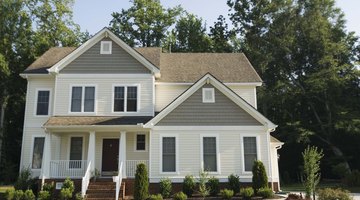How to Use Siding on a Chimney
Many residential chimneys are finished with stone or brick to help insulate them and provide a traditional appearance. However, a masonry chimney may begin to show its age over time. Replacement and resurfacing can be expensive, which makes cladding a masonry chimney with siding an attractive option in some instances.

Installing siding on a chimney requires a layer of wood furring that serves as a base for the siding itself. You can only install siding on a chimney if there is sufficient clearance between your furnace, fireplace or stove and the chimney's exterior to prevent the risk of fire.
Things You Will Need
- Pressure-treated 2-by-4s
- Masonry screws
- Tape measure
- Cordless screwdriver or power drill with screwdriver bit
- Ladder
- Insect screening
- Galvanized screws
- Vinyl siding
- Level
- Hammer
- Corrosion-resistant nails
Warning
Don't install pieces of siding too close together or nail them too tightly to the furring. Leaving space around the siding allows for expansion and will prevent cracks and other damage over time.
Only use pressure-treated lumber for furring so that it can weather the elements without rotting or swelling.
Check with your local building code department and refer to your fireplace, furnace or stove owner's manual to learn about safe clearances between the heat source and the chimney. Wood furring can catch fire if the chimney is not large enough or not sufficiently insulated.
Some communities restrict vinyl siding on masonry surfaces as a matter of aesthetics. Check local regulations to avoid fines.
Preparing the Furring
-
Screw pressure-treated 2-by-4s vertically to the surface of your chimney with masonry screws and a power driver. Create two columns of furring that extend from a few inches above the ground to the top of the chimney.
-
Set up a ladder to install furring on the higher portion of the chimney. Space the masonry screws about a foot apart and leave at least 1 foot between the two furring columns. Use a tape measure to check that the distance remains consistent as you work upward.
-
Attach insect screening near the bottom of the furring columns by screwing galvanized screws into the furring. Wrap the screening around the furring so that it extends to each edge of the chimney and prevents insects from entering the space between the siding and the masonry surface.
Hanging the Siding
-
Position a piece of siding that has been pre-ordered and cut to the width of your chimney against the wood furring near the bottom of the chimney. Check that the siding is even horizontally with a level.
-
Hammer the siding into the furring through its mounting holes with corrosion-resistant nails. Leave a 1/16-inch of space between the nail head and the siding surface.
-
Position the next piece of siding above the previously installed piece. Leave a 1/4-inch of space between rows of siding and hammer it into the furring in the same manner as with the first piece.
-
Repeat the process until the siding reaches the top of the chimney. Take off the chimney cap by removing the screws that hold it in place. Replace the cap once the top row of siding is in place.
The Drip Cap
- Many residential chimneys are finished with stone or brick to help insulate them and provide a traditional appearance.
- You can only install siding on a chimney if there is sufficient clearance between your furnace, fireplace or stove and the chimney's exterior to prevent the risk of fire.
- Set up a ladder to install furring on the higher portion of the chimney.
- Leave a 1/4-inch of space between rows of siding and hammer it into the furring in the same manner as with the first piece.
Photo Credits
- Jupiterimages/Comstock/Getty Images
- Jupiterimages/Comstock/Getty Images
More Articles



